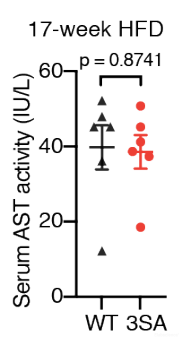Aspartate Aminotransferase (AST/GOT) Activity Assay Kit
SKU: E-BC-K236-M-500
Aspartate Aminotransferase (AST/GOT) Activity Assay Kit
| SKU # | E-BC-K236-M |
| Detection Instrument | Microplate reader (500-520 nm) |
| Detection method | Colorimetric method |
Product Details
Properties
| Synonyms | AST, GOT, Glutamic-oxalacetic transaminase |
| Sample Type | Serum, plasma, animal tissue, cells, cell culture supernatant |
| Sensitivity | 1.1 IU/L |
| Detection Range | 1.1-72.3 IU/L |
| Detection Method | Colorimetric method |
| Assay type | Enzyme Activity |
| Assay time | 80 min |
| Precision | Average inter-assay CV: 6.800% | Average intra-assay CV: 5.300% |
| Other instruments required | Micropipettor, Vortex mixer, Incubator, Multichannel pipette |
| Other reagents required | Normal saline (0.9% NaCl), PBS (0.01 M, pH 7.4) |
| Storage | 2-8℃ |
| Valid period | 12 months |
Images
H Xia et al investigate the relationship between insulin resistance and GSK3β-FBXW7-ERRα transcriptional axis. Aspartate aminotransferase (AST) activity in mouse serum was determined using AST activity assay kit (E-BC-K236-M).

No significant difference of AST activity was observed between WT and 3SA mice after HFD for 17 weeks.
Dilution of Sample
It is recommended to take 2~3 samples with expected large difference to do pre-experiment before formal experiment and dilute the sample according to the result of the formal experiment and the detection range (1.1-72.3 IU/L).
The recommended dilution factor for different samples is as follows (for reference only):
| Sample type | Dilution factor |
| Human serum | 1 |
| Human plasma | 1 |
| Porcine serum | 1 |
| Rat serum | 1 |
| HC-60 cellular supernatant | 1 |
| Calu-3 cellular supernatant | 1 |
| 10% Rat liver tissue homogenization | 15-30 |
| 10% Rat lung tissue homogenization | 2-8 |
Note: The diluent is normal saline (0.9% NaCl) or PBS (0.01 M, pH 7.4).
Detection Principle
AST/GOT enables alpha-ketoglutaric acid and aspartic acid to displace amino and keto groups to form glutamic acid and oxaloacetic acid. Oxaloacetic acid can decarboxylate itself to form Pyroracemic acid during the reaction. Pyroracemic acid reacted with 2,4-dinitrophenylhydrazine(DNPH) to form 2,4, dinitrophenylhydrazone showing reddish brown in alkaline solution. Measure the OD values and calculate the enzyme activity.

Kit Components & Storage
| Item | Component | Size 1(48 T) | Size 2(96 T) | Storage |
| Reagent 1 | Buffer Solution | 0.5 mL × 1 vial | 0.5 mL × 1 vial | 2-8℃, 12 months |
| Reagent 2 | 2 mmol/L Sodium Pyruvate |
0.5 mL × 1 vial | 0.5 mL × 1 vial | 2-8℃, 12 months |
| Reagent 3 | Substrate Solution | 2.5 mL × 1 vial | 5 mL × 1 vial | 2-8℃, 12 months |
| Reagent 4 | Chromogenic Agent | 2.5 mL × 1 vial | 5 mL × 1 vial | 2-8°C, 12 months, shading light |
| Reagent 5 | Alkali Reagent | 2.5 mL × 1 vial | 5 mL × 1 vial | 2-8℃, 12 months |
| Microplate | 96 wells | No requirement | ||
| Plate Sealer | 2 pieces | |||
Note: The reagents must be stored strictly according to the preservation conditions in the above table. The reagents in different kits cannot be mixed with each other. For a small volume of reagents, please centrifuge before use, so as not to obtain sufficient amount of reagents.
Technical Data:
Parameter:
Intra-assay Precision
Three human serum samples were assayed in replicates of 20 to determine precision within an assay. (CV = Coefficient of Variation)
| Parameters | Sample 1 | Sample 2 | Sample 3 |
| Mean (Carmen unit) | 24.00 | 61.00 | 114.00 |
| %CV | 7.9 | 6.4 | 6.1 |
Inter-assay Precision
Three human serum samples were assayed 17 times in duplicate by three operators to determine precision between assays.
| Parameters | Sample 1 | Sample 2 | Sample 3 |
| Mean (Carmen unit) | 24.00 | 61.00 | 114.00 |
| %CV | 5.5 | 5.0 | 5.4 |
Recovery
Take three samples of high concentration, middle concentration and low concentration to test the samples of each concentration for 6 times parallelly to get the average recovery rate of 97%.
| Parameters | Standard 1 | Standard 2 | Standard 3 |
|
Expected Conc. (Carmen unit) |
24 | 61 | 114 |
|
Observed Conc. (Carmen unit) |
26.04 | 59.85 | 153 |
| Recovery rate (%) | 96 | 97 | 99 |
Sensitivity
The analytical sensitivity of the assay is 1.1 IU/L. This was determined by adding two standard deviations to the mean O.D. obtained when the zero standard was assayed 20 times, and calculating the corresponding concentration.
Standard Curve
As the OD value of the standard curve may vary according to the conditions of the actual assay performance (e.g. operator, pipetting technique or temperature effects), so the standard curve and data are provided as below for reference only:
| Carmen Unit | 0 | 24 | 61 | 114 | 190 |
| Average OD | 0.222 | 0.293 | 0.361 | 0.423 | 0.479 |
| Absoluted OD | 0 | 0.071 | 0.139 | 0.201 | 0.257 |



